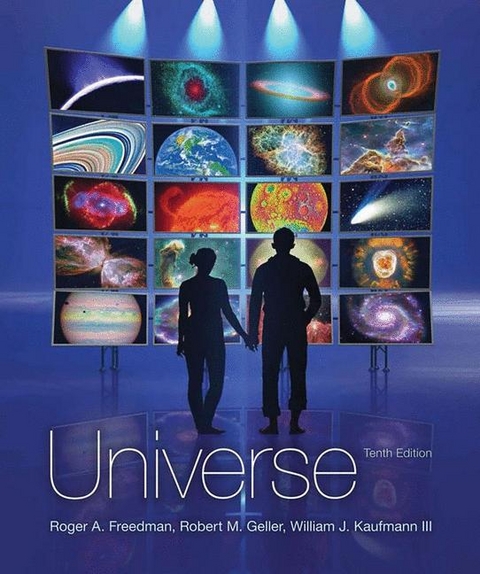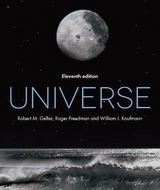
Universe
W.H.Freeman & Co Ltd (Verlag)
978-1-319-04238-7 (ISBN)
- Titel erscheint in neuer Auflage
- Artikel merken
Thoroughly updated, the new edition features the latest discoveries and new pedagogy, and is supported by an expanded media/supplements package centred on W. H. Freeman’s extraordinary new online course space, LaunchPad. See ‘Instructor Resources’ and ‘Student Resources’ for further information.
Roger A. Freedman is a Lecturer in Physics at the University of California, Santa Barbara, USA. At UCSB, Dr. Freedman has taught in both the Department of Physics and the College of Creative Studies, a branch of the university intended for highly gifted and motivated undergraduates. He has published research in nuclear physics, elementary particle physics, and laser physics. In recent years, he has helped to develop computer-based tools for learning introductory physics and astronomy and helped pioneer the use of classroom response systems and the "flipped" classroom model at UCSB. He is co-author of three introductory textbooks: University Physics (Pearson), Universe (Freeman), and Investigating Astronomy (Freeman). Robert M. Geller teaches and conducts research in astrophysics at the University of California, Santa Barbara, USA. Using data from the Hubble Space Telescope, he is currently involved in a search for bursts of lights that are predicted to occur when a supermassive black hole consumes a star. Dr. Gellar als has a strong emphasis on education, and he received the Distinguished Teaching Award at UCSB in 2003. William J. Kaufman III (deceased) was the author of the first four editions of Universe. During his career he held positions at the Griffith Observatory in Los Angeles, San Diego State University, UCLA, Caltech, and the University of Illinois. A prolific author, his many books include Black Holes and Warped Spacetime, Relativity and Cosmology, The Cosmic Frontiers of General Relativity, Exploration of the Solar System, Planets and Moons, Stars and Nebulas, Galaxies and Quasars, and Supercomputing and the Transformation of Science. Dr. Kaufmann died in 1994.
PART I: INTRODUCING ASTRONOMY
1. Astronomy and the Universe
Guest Essay: Why Astronomy? by Sandra M. Faber
2. Knowing the Heavens
Guest Essay: Why Astrology Is Not Science by James Randi
3. Eclipses and the Motion of the Moon
Guest Essay: Archaeoastronomy and Ethnoastronomy by Mark Hollabaugh
4. Gravitation and the Waltz of the Planets
5. The Nature of Light
6. Optics and Telescopes
PART II: PLANETS AND MOONS
7. Comparative Planetology I: Our Solar System
8. Comparative Planetology II: The Origin of Our Solar System
Scientific American article: Dangling a COROT by Alexander Hellemans
9. The Living Earth
10. Our Barren Moon
11. Mercury, Venus, and Mars: Earthlike yet Unique
Scientific American article: Father of Spirit and Opportunity by David Appell
12. Jupiter and Saturn: Lords of the Planets
13. Jupiter and Saturn's Satellites of Fire and Ice
14. Uranus, Neptune, Pluto, and the Kuiper Belt: Remote Worlds
15. Vagabonds of the Solar System
Guest Essay: Pluto and the Kuiper Belt by Scott Sheppard
PART III: STARS AND STELLAR EVOLUTION
16. Our Star, the Sun
17. The Nature of the Stars
18 The Birth of Stars
19. Stellar Evolution: On and After the Main Sequence
20. Stellar Evolution: The Deaths of Stars
21. Neutron Stars
22. Black Holes
PART IV: GALAXIES AND COSMOLOGY
23. Our Galaxy
24. Galaxies
25. Quasars and Active Galaxies
26. Cosmology: The Origin and Evolution of the Universe
Scientific American article: Dark Forces at Work by David Appell
27. Exploring the Early Universe
Scientific American article: Making Sense of Modern Cosmology by P. James E. Peebles
28. The Search for Extraterrestrial Life
Guest Essay: A Biologist's View of Astrobiology by Kevin W. Plaxco
| Zusatzinfo | Approx. 800 p. |
|---|---|
| Sprache | englisch |
| Themenwelt | Naturwissenschaften ► Physik / Astronomie ► Astronomie / Astrophysik |
| ISBN-10 | 1-319-04238-4 / 1319042384 |
| ISBN-13 | 978-1-319-04238-7 / 9781319042387 |
| Zustand | Neuware |
| Haben Sie eine Frage zum Produkt? |
aus dem Bereich



